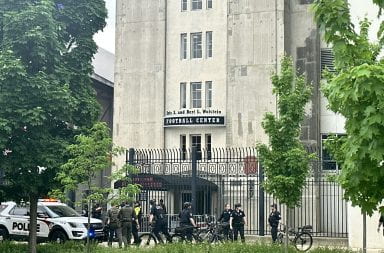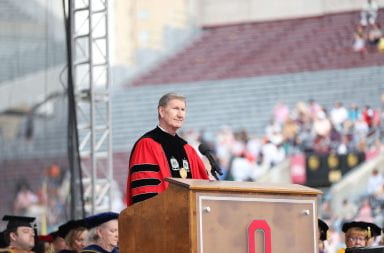The Bengals need to get greedy.
Sure they have a superstar-in-the-making at wide receiver with A.J. Green.
And yes, Andy Dalton is coming off one of the greatest rookie seasons in league history for a quarterback.
And don’t forget they have a stout, young defense that ranked 7th overall, despite missing key members who are back in the fold this year.
But why stop there?
Because they’re the Bengals?
Since Cincinnati has been an NFL punchline for more than a decade, now they should be satisfied with merely making the playoffs?
Would New England’s coach Bill Belichick and its owner, Bob Kraft, stand for such mediocrity?
When the Patriots think they don’t have what it takes to win a Super Bowl, do you know what they do? They reload.
In 2004, still fresh off a Super Bowl win, New England traded for Corey Dillon, the Bengals’ all-time rushing leader. Result? Dillon set career and franchise records in rushing while playing a key role in the Patriots’ run to another world championship.
In 2007, the Patriots realized Tom Brady had no real weapons in the passing game. They added receivers Wes Welker and Randy Moss.
And how did that turn out? Well, Brady set the all-time single-season record for touchdowns thrown, Moss broke Jerry Rice’s 20-year record for receiving touchdowns and the team proceeded to go 16-0 in the regular season, only to lose in shocking fashion to the Giants in the Super Bowl.
Teams built for the playoffs usually have three key elements: 1) A stout defense that knows how to make plays that lead to points, 2) A solid passing game with big-play ability, and 3) The ability to grind out wins on the ground. The Bengals have the first two components but are in desperate need of the third.
It is no stretch to say that should the Bengals find a top-flight runner, they could very well be primed for a run deep into the postseason. And it isn’t very often that an elite running back who is just entering his prime comes along. That’s where Jacksonville running back Maurice Jones-Drew comes in.
Jones-Drew wants to be paid like a top back and, for whatever reason, the Jaguars don’t want to rework Jones-Drew’s contract. Perhaps their concern is that by the time they are competitive, Jones-Drew will be on the downside of his career, as is the case for most running backs as they approach 30.
That makes perfect sense for the Jaguars. The Bengals, however, find themselves in a completely different position.
Here are the facts: the Bengals have a surplus of young talent on both offense and defense. They are not in great need of high draft picks, while the Jaguars are. Give Jacksonville owner Shahid Khan what he wants. I think a first- and a third-round draft pick to go along with a second and fourth next year should do the trick. But if it doesn’t, up the ante. Whatever it takes. This team isn’t going very far without a running game and, I’m sorry, but I just don’t see Bengals running back BenJarvus Green-Ellis carrying them to the Super Bowl.
Longtime NFL observers know that adding another team’s star doesn’t usually work out. Dan Snyder of the Redskins is a great example of an owner who learned this valuable lesson the hard way. Even a franchise as solid as the Eagles couldn’t make the most of their free agent signings last year.
But none of those teams added players that were in a position to contribute to their team’s success the way Jones-Drew is. The Redskins added aging veterans (Deion Sanders, Bruce Smith) on defense, the Eagles added the greatest cornerback in the game (Nnamdi Asomugha) to a secondary that was already one of the league’s best.
Big-name signings that went right include the Patriots aforementioned moves, the Saints’ signing of Drew Brees or the Rams trading for Marshall Faulk. Even Terrell Owens made an instant impact on the Eagles upon arriving in 2004. Coincidentally, that was the same year they made the lone Super Bowl appearance of coach Andy Reid’s tenure.
And running backs tend to be big contributors, so as long as they are not merely beneficiaries of a great offensive scheme. Think Jerome Bettis going to the Steelers, Curtis Martin to the Jets or Priest Holmes to the Chiefs. And if one counters with the likes of Clinton Portis, who topped 1,500 yards twice before the age of 23, the obvious response would be that the Broncos and their speedy offensive line were churning out 1,000-yard runners left and right. The Redskins wanted Portis, who simply had the good fortune of playing in Denver, to save their anemic rushing attack.
Jones-Drew, meanwhile, is on a team not known for its brilliant offensive schemes. Though Jacksonville went 5-11 last year and featured one of the league’s worst offenses trying to break in a rookie quarterback, Jones-Drew somehow found the room to run for more than 1,600 yards. Imagine him on the Bengals, protecting leads, finishing off opponents.
All of a sudden, Andy Dalton goes from being an above-average quarterback to, dare I say, Troy Aikman. A.J. Green goes from being one of the league’s most promising young receivers to Michael Irvin. Yes, that is possible. That is what a workhorse back (like Emmitt Smith) adds to a team. On the condition, of course, that they have all the other parts in place. And with star cornerback Leon Hall and defensive leader Rey Maualuga healthy again, Cincinnati’s defense, one of the best last year, has nowhere to go but up.
Jones-Drew wants a trade. The Jags deny they have any interest in doing so. It’s time for the Bengals to get pushy and make it happen.


